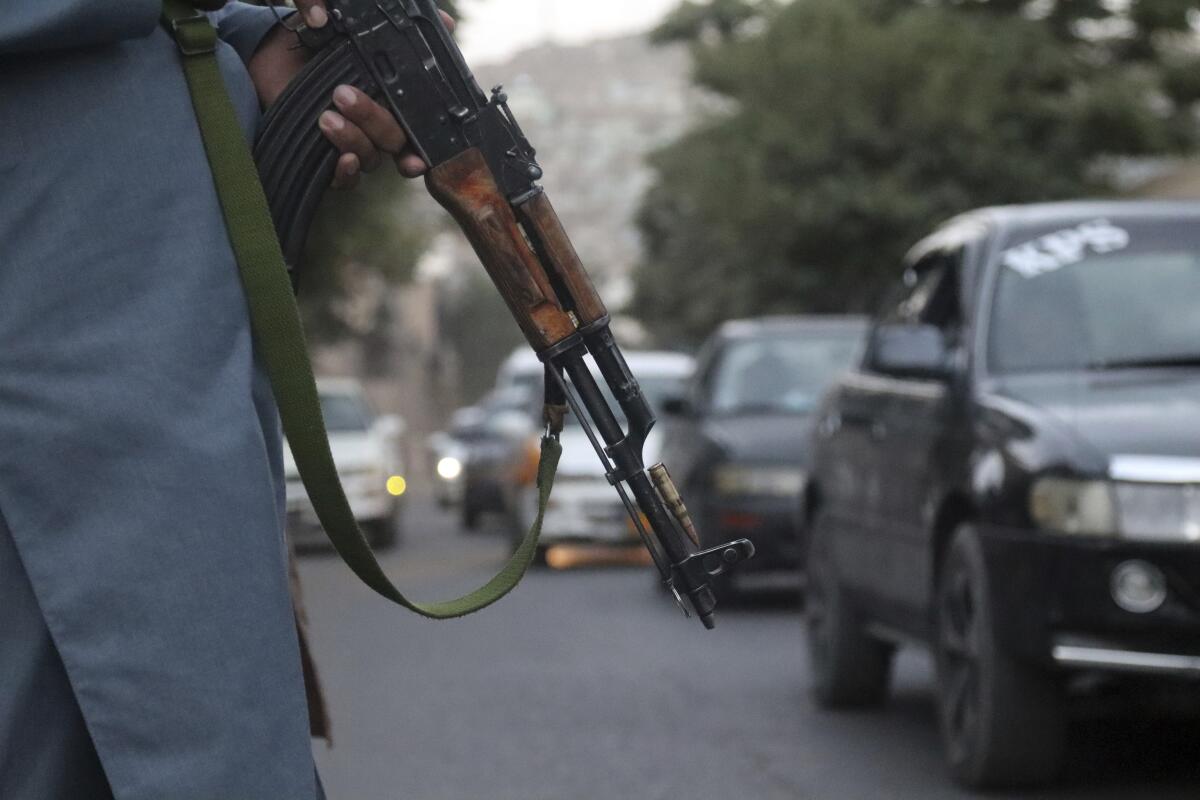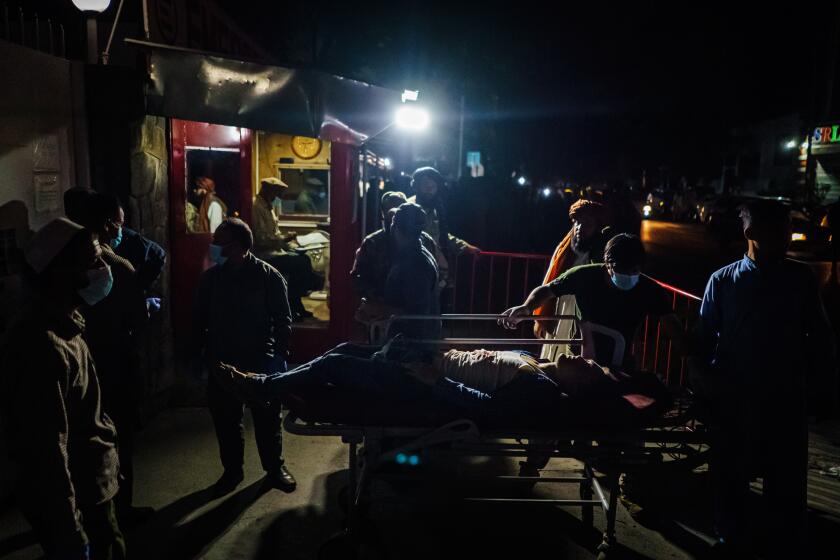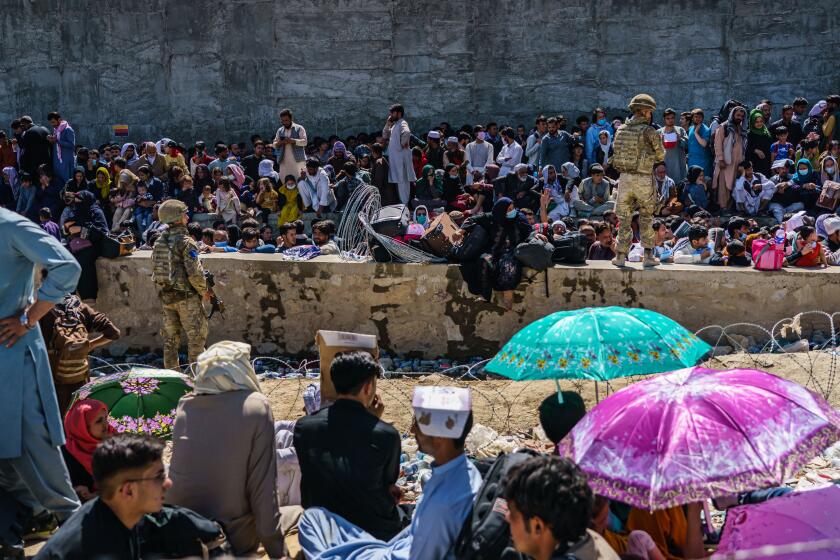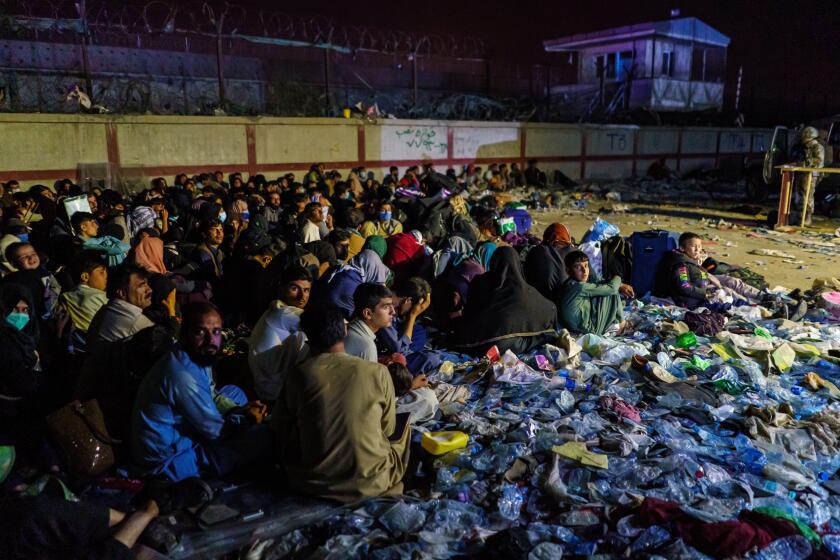Taliban blocks access to Kabul airport for most Afghans as foreign evacuations wane

- Share via
KABUL, Afghanistan — Taliban forces sealed off Kabul’s airport to most Afghans hoping for evacuation on Saturday as the U.S. and its allies wound down a chaotic airlift that will end their troops’ two decades in Afghanistan.
Western leaders acknowledged that their withdrawal would mean leaving behind some of their citizens and many locals who helped them over the years, and they vowed to try to continue working with the Taliban to allow local allies to leave after President Biden’s Tuesday deadline to withdraw from the country.
Although most of its allies had finished their evacuation flights, the U.S. planned to keep its round-the-clock flights going until the deadline, saying 117,000 people had been evacuated since the Taliban claimed Kabul on Aug. 15. Biden warned Saturday that commanders had told him another attack was “highly likely in the next 24-36 hours.”
Britain ended its evacuation flights Saturday, though Prime Minister Boris Johnson promised to “shift heaven and earth” to get more of those at risk from the Taliban to Britain by other means.
Britain’s ambassador to Afghanistan, Laurie Bristow, said in a video from the Kabul airport and posted on Twitter that it was “time to close this phase of the operation now.”
“But we haven’t forgotten the people who still need to leave,” he said. “We’ll continue to do everything we can to help them. Nor have we forgotten the brave, decent people of Afghanistan. They deserve to live in peace and security.”
Heartbroken family members begin sharing the names of those killed in Afghanistan through interviews and social media.
As the flow of planes leaving Kabul slowed, others arrived in locales around the world carrying Afghans who managed to secure places on the last evacuation flights, including in the Washington, D.C., area, Philadelphia, Madrid and Birmingham, England, among others. Some were relieved and looking forward to starting their new lives far from the Taliban, but others were bitter about having to flee.
In Spain, evacuee Shabeer Ahmadi, a 29-year-old journalist targeted by the Taliban, said the United States had doomed the work he and others had dedicated to making Afghanistan a better place by allowing the insurgent group to reclaim power.
“They abandoned the new generation of Afghanistan,” Ahmadi said.
An evacuation transport to Britain landed with an extra passenger on Saturday after the cabin crew delivered a baby girl in midflight, Turkish media reported. The parents named her Havva, or Eve, and she was at least the fourth baby known to have been born to Afghan mothers during evacuation flights.
Meanwhile, families of Afghans killed in Thursday’s suicide bombing at the airport by an Islamic State group affiliate continued burying their dead. At least 169 Afghans and 13 U.S. service members died in the attack. Among those killed was Belal Azfali, a 36-year-old contractor for a U.S.-funded project who had gone to the airport on his own, without his wife. His remains were so disfigured that he could only be identified when someone answered a call from his family to his cellphone, relatives said.
The U.S. on Saturday released the names of the 13 Marines, Navy and Army personnel who were killed in the bombing. One of the Marines — recently promoted Marine Sgt. Nicole Gee, 23 — was seen in widely circulated photos cuddling Afghan infants they had temporarily rescued from the crush of the crowds outside the airport gates this month.
The Pentagon says two Islamic State of group members were killed in a drone strike in eastern Afghanistan, not one as initially reported.
Taliban spokesman Zabihullah Mujahid claimed Saturday that the group’s forces were holding some positions within the airport and were ready to peacefully take control of it as American forces flew out. But Pentagon spokesman John Kirby disputed that description of the situation.
The Taliban did deploy extra forces outside the airport to prevent large crowds from gathering in the wake of Thursday’s bombing. New layers of checkpoints sprang up on roads leading to the airport, some manned by uniformed Taliban fighters with Humvees and night-vision goggles captured from Afghan security forces. Areas where crowds had gathered over the past two weeks in the hopes of fleeing the country were largely empty.
Officials said U.S. forces were taking every precaution at the airport, as there were concerns that Islamic State, which is far more radical than the Taliban, could strike again. In his statement saying another attack was highly likely, Biden said a drone strike he ordered that killed what military officials described as two “high-profile” Islamic State militants believed to have been involved in planning or facilitating attacks would not be his “last” response to Thursday’s suicide attack.
An Afghan who worked as a translator for the U.S. military said he was with a group of people with permission to leave who tried to reach the airport late Friday. After passing through three checkpoints they were stopped at a fourth. An argument ensued, and the Taliban said they had been told by the Americans to only let U.S. passport-holders through.
“I am so hopeless for my future,” the man later told the Associated Press, speaking on condition of anonymity because of security concerns. “If the evacuation is over, what will happen to us?”
Kirby, the Pentagon spokesman, said Saturday that Afghans who had worked with American forces still were being allowed in.
You can help Afghan refugees by donating money to or volunteering with organizations in California.
According to a State Department spokesperson, 5,400 Americans and likely more have been safely evacuated from Afghanistan since Aug. 14, including nearly 300 Americans in the last day. Another 350 were still seeking to leave, and those were the only ones the department could confirm were still in Afghanistan.
Biden has said he will adhere to a self-imposed Tuesday deadline for withdrawing all U.S. forces, and the Taliban have rejected any extension. They have encouraged Afghans to stay, pledging amnesty even to those who fought against them, and have said commercial flights would resume after the U.S. withdrawal, but it’s unclear if airlines will be willing to offer service.
As Tuesday’s deadline draws near, and with the Taliban controlling nearly all of the country, hundreds of Afghans, including many civil servants, gathered to protest outside a bank while countless more lined up at cash machines. Many said they hadn’t been paid for three to six months and were unable to withdraw cash. ATMs were still operating, but withdrawals were limited to about $200 every 24 hours. Later Saturday, the central bank ordered commercial bank branches to open and allow customers to withdraw $200 per week, calling it a temporary measure.
The economic crisis, which predates the Taliban takeover, could give Western nations leverage as they urge Afghanistan’s new rulers to form a moderate, inclusive government and allow people to leave after Tuesday.
Afghanistan is heavily dependent on international aid, which covered around 75% of the toppled Western-backed government’s budget. The Taliban has said it wants good relations with the international community and has promised a more moderate form of Islamic rule than when they last governed the country, but many Afghans are deeply skeptical.
The terrorist group Islamic State in Khorasan, known as ISIS-K, is thought to be responsible for Thursday’s deadly bombing near the airport. Here’s what we know about it.
The Taliban cannot access almost any of the central bank’s $9 billion in reserves, most of which is held by the New York Federal Reserve and has been frozen. The International Monetary Fund has also suspended the transfer of some $450 million. Without a regular supply of U.S. dollars, the local currency, the afghani, is at risk of collapse, which could send the price of basic goods soaring.
The U.S. and its allies have said they will continue providing humanitarian aid to Afghanistan through the U.N. and other partners, but any broader engagement — including development assistance — is likely to hinge on whether the Taliban delivers on its promises of more moderate rule.
More to Read
Sign up for Essential California
The most important California stories and recommendations in your inbox every morning.
You may occasionally receive promotional content from the Los Angeles Times.

















